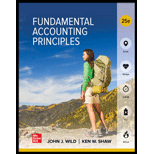
FUND.ACCT.PRIN.
25th Edition
ISBN: 9781260247985
Author: Wild
Publisher: RENT MCG
expand_more
expand_more
format_list_bulleted
Question
Chapter 9, Problem 18E
To determine
Concept Introduction: Notes receivable are promissory notes, a written promise to pay a specific amount of money. The replacement of
The
Expert Solution & Answer
Want to see the full answer?
Check out a sample textbook solution
Students have asked these similar questions
Do fast answer of this accounting questions
Hi expert please give me answer general accounting question
General accounting question
Chapter 9 Solutions
FUND.ACCT.PRIN.
Ch. 9 - Credit card sales Prepare journal entries for the...Ch. 9 - Direct write-off method P1 Solstice Company...Ch. 9 - Recovering a bad debt P1 Solstice Company...Ch. 9 - Distinguishing between allowance method and direct...Ch. 9 - Prob. 5QSCh. 9 - Allowance method for bad debts P2 Gomez Corp. uses...Ch. 9 - Reporting allowance for doubtful accounts P2 On...Ch. 9 - Prob. 8QSCh. 9 - Prob. 9QSCh. 9 - Aging of receivables method P3 ^ Net Zero...
Ch. 9 - Prob. 11QSCh. 9 - Prob. 12QSCh. 9 - Prob. 13QSCh. 9 - Prob. 14QSCh. 9 - Prob. 15QSCh. 9 - Prob. 16QSCh. 9 - Prob. 17QSCh. 9 - Prob. 18QSCh. 9 - Prob. 19QSCh. 9 - Prob. 20QSCh. 9 - Prob. 21QSCh. 9 - Exercise 9-1
Accounts receivable subsidiary...Ch. 9 - Prob. 2ECh. 9 - Exercise 9-3
Sales on store credit card
C1
Z-Mart...Ch. 9 - Exercise 9-4
Direct write-off method
Dexter...Ch. 9 - Exercise 9-5 Writing off receivables P2
On January...Ch. 9 - Exercise 9-6 Percent of sales method; write-off...Ch. 9 - Exercise 9-7 Percent of accounts receivable...Ch. 9 - Exercise 9-8 Aging of receivables method P3
Daley...Ch. 9 - Exercise 9-9 Percent of receivables method...Ch. 9 - Exercise 9-10 Aging of receivables schedule...Ch. 9 - Exercise 9-10
Estimating bad debts
P3
At December...Ch. 9 - Exercise 9-11
Notes receivable...Ch. 9 - Exercise 9-12
Notes receivable transactions...Ch. 9 - Exercise 9-14 Honoring a note P4
Prepare journal...Ch. 9 - Exercise 9-15 Dishonoring a note P4
Prepare...Ch. 9 - Exercise 9-16 Selling and pledging accounts...Ch. 9 - Exercise 9-17 Accounts receivable turnover A1 Q...Ch. 9 - Prob. 18ECh. 9 - Prob. 19ECh. 9 - Prob. 20ECh. 9 - Prob. 21ECh. 9 - Prob. 22ECh. 9 - Prob. 23ECh. 9 - Problem 9-1A Sales on account and credit card...Ch. 9 - Problem 9-2A Estimating and reporting bad debts P2...Ch. 9 - Problem 9-3A Aging accounts receivable and...Ch. 9 - Problem 9-4A Accounts receivable transactions and...Ch. 9 - Problem 9-5A Analyzing and journalizing notes...Ch. 9 - Problem 9-1B Sales on account and credit card...Ch. 9 - Problem 9-2B Estimating and reporting bad debts P2...Ch. 9 - Problem 9-3B Aging accounts receivable and...Ch. 9 - Problem 9-4B Accounts receivable transactions and...Ch. 9 - Prob. 5PSBCh. 9 - SP 9 Santana Rey: owner of Business Solutions,...Ch. 9 - Prob. 1GLPCh. 9 - Prob. 1AACh. 9 - Prob. 2AACh. 9 - Prob. 3AACh. 9 - Prob. 1DQCh. 9 - Why does the direct write-off method of accounting...Ch. 9 - Prob. 3DQCh. 9 - Why might a business prefer a note receivable to...Ch. 9 - Prob. 5DQCh. 9 - Prob. 6DQCh. 9 - Anton Blair is the manager of a medium-size...Ch. 9 - Prob. 2BTNCh. 9 - Prob. 3BTNCh. 9 - Prob. 4BTNCh. 9 - Prob. 5BTN
Knowledge Booster
Similar questions
- Can you help me with accounting questionsarrow_forwardAcorn Construction (calendar-year-end C corporation) has had rapid expansion during the last half of the current year due to the housing market's recovery. The company has record income and would like to maximize its cost recovery deduction for the current year. (Use MACRS Table 1, Table 2, Table 3, Table 4, and Table 5.) Note: Round your answer to the nearest whole dollar amount. Acorn provided you with the following information: Asset Placed in Service Basis New equipment and tools August 20 $ 3,800,000 Used light-duty trucks October 17 2,000,000 Used machinery November 6 1,525,000 Total $ 7,325,000 The used assets had been contributed to the business by its owner in a tax-deferred transaction two years ago. a. What is Acorn's maximum cost recovery deduction in the current year?arrow_forwardGeneral accountingarrow_forward
- Multiple Choice 2-32 Educational Incentives (LO 2.14) Wendy is a single taxpayer and pays tuition of $7,800 in 2021. Her 2021 AGI is $66,000. What is the amount of Wendy's tuition deduction? X a. $2,000 O b. $0 O c. $3,733.33 O d. $4,000 O e. $7,800arrow_forwardMultiple Choice 2-32 Educational Incentives (LO 2.14) Wendy is a single taxpayer and pays tuition of $7,800 in 2021. Her 2021 AGI is $66,000. What is the amount of Wendy's tuition deduction? X a. $2,000 O b. $0 O c. $3,733.33 O d. $4,000 O e. $7,800arrow_forwardNonearrow_forward
arrow_back_ios
SEE MORE QUESTIONS
arrow_forward_ios
Recommended textbooks for you
 Financial Accounting: The Impact on Decision Make...AccountingISBN:9781305654174Author:Gary A. Porter, Curtis L. NortonPublisher:Cengage Learning
Financial Accounting: The Impact on Decision Make...AccountingISBN:9781305654174Author:Gary A. Porter, Curtis L. NortonPublisher:Cengage Learning College Accounting, Chapters 1-27AccountingISBN:9781337794756Author:HEINTZ, James A.Publisher:Cengage Learning,
College Accounting, Chapters 1-27AccountingISBN:9781337794756Author:HEINTZ, James A.Publisher:Cengage Learning,- Principles of Accounting Volume 1AccountingISBN:9781947172685Author:OpenStaxPublisher:OpenStax CollegeCentury 21 Accounting Multicolumn JournalAccountingISBN:9781337679503Author:GilbertsonPublisher:Cengage


Financial Accounting: The Impact on Decision Make...
Accounting
ISBN:9781305654174
Author:Gary A. Porter, Curtis L. Norton
Publisher:Cengage Learning

College Accounting, Chapters 1-27
Accounting
ISBN:9781337794756
Author:HEINTZ, James A.
Publisher:Cengage Learning,

Principles of Accounting Volume 1
Accounting
ISBN:9781947172685
Author:OpenStax
Publisher:OpenStax College

Century 21 Accounting Multicolumn Journal
Accounting
ISBN:9781337679503
Author:Gilbertson
Publisher:Cengage